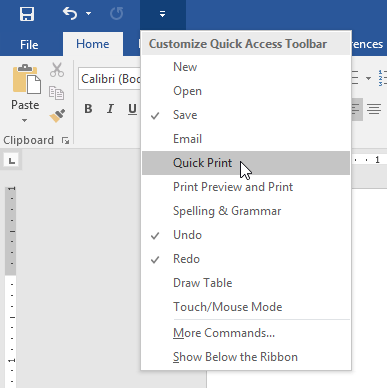

- #Create a quick part in word 2013 drivers#
- #Create a quick part in word 2013 windows 10#
- #Create a quick part in word 2013 code#
- #Create a quick part in word 2013 windows#
Set objCommonDialog = New WIA.CommonDialog

' Author: Günter Born ' Implements a Scan function in Word 2013/2016
#Create a quick part in word 2013 code#
I've prepared the following VBA code for this purposes.

Add the macro codeĪfter rerencing the WIA library, we are ready to insert the necessary VBA code into the Scan() module. Then the library wiaaut.dll will be referenced within the VBA project, so we can access the classes provided by this DLL.
#Create a quick part in word 2013 windows#
Check Microsoft Windows Image Acquisition Library v2.0 in dialog box References and confirm OK button. Opens Tools menu an select command References.Ģ. Important: Set a reference to WIA libraryīefore we enter the macro code, it's important, to create a reference to the WIA class library used in VBA.ġ. The Visual Basic development environment with an empty macro "Scan" might be visible (see below). Select Normal.dotm (global template) in Macros in, add a macro name "Scan" into Macro name text box, enter an optional description and hit the Create button. Go to View tab, and select Macros – View Macros.Ģ. Now it's time to invoke the VBA development environment in Word 2016 (it works also in Word 2013).ġ.
#Create a quick part in word 2013 windows 10#
I wasn't able to switch my Windows 10 account the English, although this has been the default language before I installed Office 2016 with multiple languages. Multi page scans are dicussed here – maybe it's helpful for further reading.īTW: The dialog boxes shown above are still in German, because I use a German Windows 10 – and it seems there are conflicts between Windows language packs and Office 2016 language packs. Not supported are multi page scans, because I don't have such a device – and it seems, that WIA doesn't support this feature. Using the scan button invokes a scan, stores the scan into a temporary image file (jpeg) and inserts the scan into word at the current text cursor position. Within this dialog box we can select scan options and do a preview scan. Selecting a device and confiming OK button invokes the WIA dialog box to access a scanner.

If several WIA sources are present, Windows asks to select a WIA device (iPad, Digicam, and Scanner for instance). The VBA macro introduced here enables Word 2013 or Word 2016 to initiate a scan via a push button using the WIA interface. There is a mdlTwain library available at mdlTwain.zip and within my German blog post is a comment with a code snippet to access a TWAIN scan interface. The TWAIN interface supported from several scanner vendors isn't suitable for our purposes.
#Create a quick part in word 2013 drivers#
But this requires that the WIA interface is supported in Windows – which means: The scanner vendor needs to provide compatible WIA drivers for the used Windows version. Microsoft Windows Image Acquisition Library v2.0 provides a class library useable from VBA. Microsoft Windows Image Acquisition Library v2.0 – provided in Windows 7, 8, 8.1 and 10 – enable us to access a scanner from VBA. VBA is object oriented, so it's possible to instantiate objects from class libraries, and use methods and properties from these objects to access a scanner from applications like Word. VBA stands for Visual Basic for Application, a Basic oriented programming language, available in Microsoft Office to write macros. Within this blog post I'm using a few technical terms. So I haven't polished the macro solution too much. First of all, I need to confess, it hat been a while, since I wrote my last VBA book (Microsoft Word 97, Developer's Kit – The technical reference, Microsoft Press Germany).


 0 kommentar(er)
0 kommentar(er)
